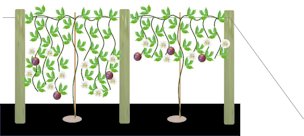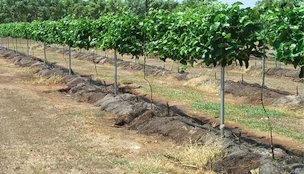Horizontal
trellises have cross-pieces at the top of each post with 2-4 wires
strung horizontally 60 cm (2 ft.) apart along the top of each
cross-piece. Vertical trellises consist of heavy posts without
cross-pieces, with 2 or 3 wires strung along the row like barbed wire
fencing, attached to the posts from the top down at intervals about
30-40 cm (12-16 in.) apart.
1
Trellis wires should be No. 9 or 10
galvanized steel. The posts need to be stout enough to withstand the
weight of the vines throughout a season that normally includes the
buffeting of strong winds. Ideally they should be long enough to
provide a trellis height of 1.5 m (5 ft.), with 45-75 cm (18-30 in.) in
the ground. Trellis rows should be oriented north-south for maximum
exposure to sunlight, and the vines should be allowed to grow together
along the trellises to promote cross-pollination.
1
Passion vines
in their native state clamber up available trees or rocks and spread
out to catch the available sunlight. The yellow passion fruit has
naturalized in this manner in some parts of southern Florida. In
cultivation, vines should be trained to cover the wires of the trellis
or fence on which they are grown.
1Young vines are
trained by
aiming a growing up toward the top of the trellis and once there,
allowing a shoot to grow along each wire in each direction. A 2-wire
trellis provides 4 sprouts growing along the trellis away from
the vine's trunk. Once started, the vine should be allowed to grow
without pruning throughout the season, since the more vine there is,
the more bearing surface there will be. With self-incompatible forms of
yellow passion fruit it is particularly desirable to allow 2 different,
cross-fertile vines to grow through each other and intertwine so as to
promote heavy fruit production.
1
Depending
upon the trellis design, vines should be trained to grow in a manner
that maximizes the canopy surface area. An option is a “curtain”
training system (Fig. 1), in which one main stem reaches to the top
support wire, with vines spreading horizontally and then drooping down
like a curtain to fill in the open space below
. 2
If laterals do not emerge in time, they can be forced to leaf out by
pinching off the shoot tip. When the vines reach the wire they are
trained in opposite directions along it. All laterals below the wire
are pruned off. Laterals emerging along the wire are allowed to hang
down freely; they are the secondary shoots branching into tertiary
shoots. Secondary and higher order shoots are the fruiting wood which
has to be thinned and rejuvenated by pruning.
3
Vines
should be pruned in late winter when they are not actively growing. Use
a 10% bleach solution or quaternary ammonium to disinfect cutting tools
between each plant to avoid spreading disease. Over time, if left
unmanaged, the new vine growth may become dense and cover older vine
growth that loses its leaves, forming a thatch-like canopy composed of
dead leaves. This can be a source of fungal diseases that negatively
affect new leaves and fruit quality
. 2
Vines
can be pruned back to the main vine or healthy branches from the main
vine. All dead and weak stems should be pruned out and pruned back to
vigorous stems so that they can resume healthy, active growth in early
spring. A good time to make the first fertilizer application is after
pruning
. 2
The passion vine is a short-lived
perennial. Some yellow passion fruit vines in southern Florida have
persisted in the field for 10 years, but this is exceptional. A more
realistic life expectation is 3-5 years. A vine that appears to have
excessive deadwood may have lost so much vigor that it should be
removed and replaced with a young, healthy plant.
1
Fig. 1
Illustration of “curtain” training on a vertical trellis; older stage
on left.
Fig. 2


